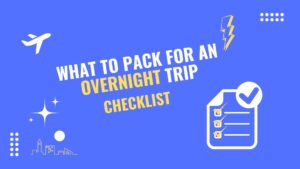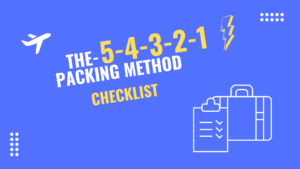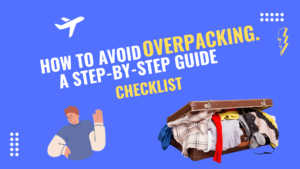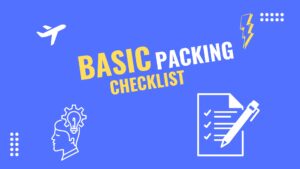Introduction
Traveling light is more than just a trend, it’s a mindset. For minimalist travelers, digital nomads, one-bag packers, and eco-conscious explorers, packing is both an art and a science. The age old question remains: Suitcase or backpack?
The answer isn’t one size fits all. This backpack vs. suitcase minimalist packing checklist will help you make an informed decision while offering a complete minimalist travel checklist to ensure you pack smart, not heavy.
Whether you’re planning a weekend city escape or a multi month adventure, understanding the pros and cons of each option and how to pack efficiently can make your trip smoother, cheaper, and more enjoyable. Let’s dive into everything you need to know.
Backpack vs. Suitcase Minimalist Packing Checklist: Key Differences
Mobility and Terrain
- Backpack: Best for cobblestone streets, stairs, and rural or rugged areas.
- Suitcase: Ideal for smooth pavements, elevators, and urban environments.
Accessibility and Organization
- Suitcases typically offer better compartmentalization.
- Backpacks often require unpacking to find buried items.
Weight Distribution and Carrying Comfort
- Backpacks put the weight on your back and shoulders—great for short durations.
- Rolling suitcases shift the weight off your body but are bulkier.
Comparison Chart: Backpack vs. Suitcase
| Feature | Backpack | Suitcase |
| Mobility | Great for stairs, rough terrain | Best on flat, smooth surfaces |
| Accessibility | Top-loading or zippered compartments | Easy access with compartments |
| Weight Distribution | On back and shoulders | Rolled; no body strain |
| Durability | More rugged, better for outdoors | Better for urban & airport travel |
| Organization | Requires packing cubes or organizers | Built-in compartments |
| Best For | Backpackers, adventure travelers | Business travelers, urban explorers |
| Carry-On Friendly | Usually 30–40L capacity | Standard carry-on sizes available |
| Comfort Over Time | Can strain shoulders on long walks | Easier on body for longer durations |
| Storage Space | Less structured; flexible | Structured; fits more in tighter space |
| Weather Resistance | Can come with rain covers | Some are hard-shell, water-resistant |
Minimalist Packing Philosophy
The 80/20 Rule
Pack for 20% of your needs and trust that 80% can be adapted, borrowed, or bought if necessary.
Quality Over Quantity
Invest in travel-ready gear that performs multiple functions—like convertible pants, multi-use shoes, and quick-dry clothing.
Essential Travel Checklist for Minimalists
Clothing (Capsule Wardrobe)
- 2-3 T-Shirts (quick-dry, neutral tones)
- 1-2 Pairs of Pants or Convertible Pants
- 1 Pair of Shorts
- 1-2 Casual Shirts or Dresses
- 3 Pairs of Underwear
- 2 Pairs of Socks
- 1 Lightweight Jacket or Windbreaker
- 1 Pair of Comfortable Shoes (sneakers or hybrid travel shoes)
- 1 Pair of Flip-Flops or Sandals (optional)
Toiletries (Carry-On Friendly)
- Toothbrush & Toothpaste
- Small Comb or Travel Brush
- Shampoo/Body Wash (refillable 100ml containers)
- Razor
- Sunscreen (solid or stick if possible)
- Deodorant (solid or crystal)
Electronics
- Smartphone + Charger
- Universal Adapter
- Lightweight Laptop or Tablet (if needed)
- Power Bank
- Noise-Cancelling Earbuds
Miscellaneous Essentials
- Travel Towel
- Packing Cubes or Compression Bags
- Travel Wallet
- Reusable Water Bottle
- Travel Insurance Card or Digital Copy
- Pen & Notebook
Suitcase Packing Tips
Use Compartments Wisely
Designate sections for clothing, toiletries, and gadgets to prevent clutter.
Rolling vs. Folding
Rolling clothes saves space and prevents wrinkles.
Invest in a Carry-On Size Suitcase
If you’re flying, aim for one that fits international airline standards (22x14x9 inches).
Backpack Packing Tips
Distribute Weight Evenly
Heavier items close to your spine, lighter gear towards the outside.
Use Packing Cubes
They make accessing clothes easier and maintain structure.
Choose the Right Backpack
30-40L is usually ideal for minimalist travel. Look for one with front-loading access, padded straps, and a hip belt.
Choosing Based on Trip Type
Business Travel
- Go with a suitcase for wrinkle-free clothes and sleek organization.
- Add a compact garment folder.
Adventure Travel
- A backpack wins in mobility and ease of access.
- Waterproof or water-resistant bags are a plus.
Digital Nomad Life
- Hybrid setups (backpack with a detachable daypack) offer flexibility.
- Make room for tech and organize cables efficiently.
Destination Matters
Urban vs. Rural
- Urban: Suitcases excel.
- Rural: Backpacks are easier to manage.
Climate & Weather
- Wet or snowy conditions may damage roller wheels.
- Dry climates favor either bag type.
Packing Cubes: The Unsung Hero
Benefits
- Organize by type or outfit
- Compress bulky items
- Make repacking easier
Common Mistakes Minimalists Should Avoid
- Over-packing “just in case” items
- Ignoring weight limits
- Using low quality gear
- Not trying a test pack before travel
Quick Takeaways
- Backpacks are ideal for mobility, flexibility, and off the beaten path travel.
- Suitcases offer better organization, protection, and are great for business or urban travel.
- Minimalist packing focuses on essentials, multi use items, and smart gear.
- Using packing cubes, digital checklists, and ultralight items can optimize space.
- Choose luggage based on destination, trip type, duration, and personal comfort.
Conclusion
In backpack vs. suitcase minimalist packing checklist game, choosing between a suitcase and a backpack comes down to how you travel, not just where. Backpacks bring flexibility and are ideal for rugged, fast-paced travel. Suitcases offer protection and organization, perfect for urban explorers and business trips. Regardless of which you choose, packing smart is the real secret. Embrace the minimalist mindset pack light, travel far, and focus more on the journey than the luggage.
Now that you have the tools and tips, it’s time to test your packing skills. Which are you bringing on your next adventure?
FAQs
Qus. 1. Can I use both a backpack and a suitcase?
Ans. Yes, many travelers use a suitcase for main luggage and a small backpack as a personal item or daypack.
Qus. 2. What size backpack is best for minimalist travel?
Ans. 30-40L backpacks are ideal for carry-on minimalist packing.
Qus. 3. Are packing cubes helpful?
Ans. Absolutely. They help organize, compress, and separate clothes and accessories.
Qus. 4. What if I forget something?
Ans. Minimalist packing assumes you can purchase small missing items during travel.
Qus. 5. Is it better to roll or fold clothes?
Ans. Rolling typically saves more space and reduces wrinkles.






